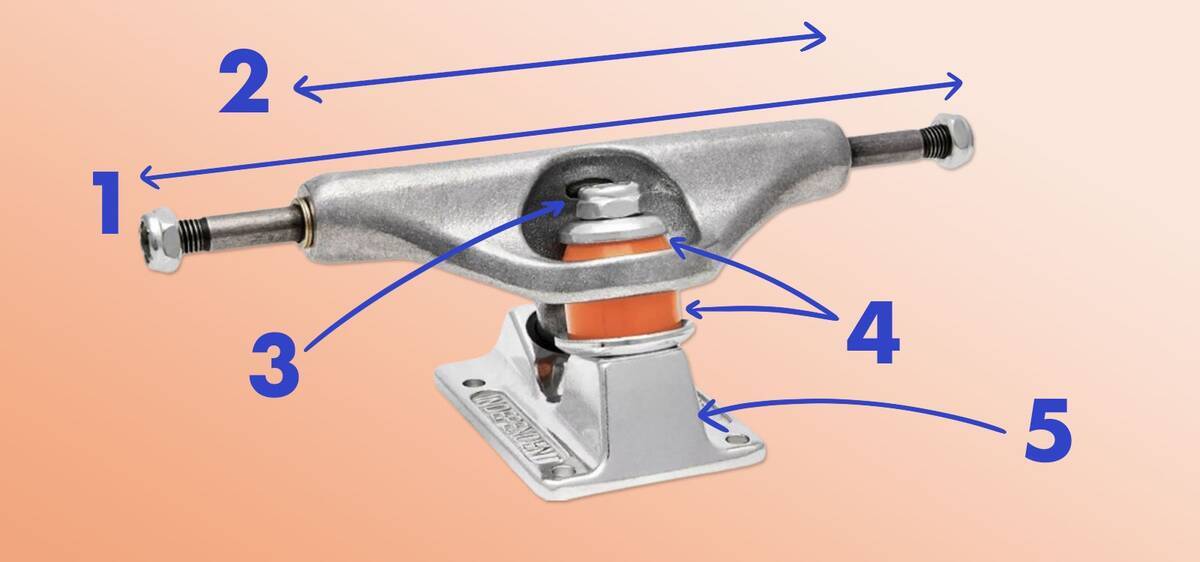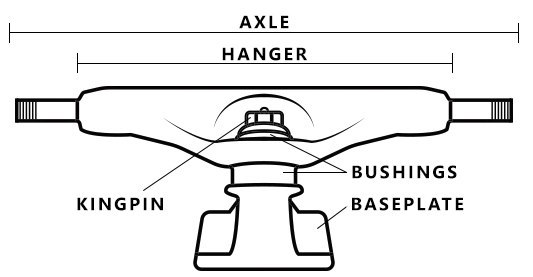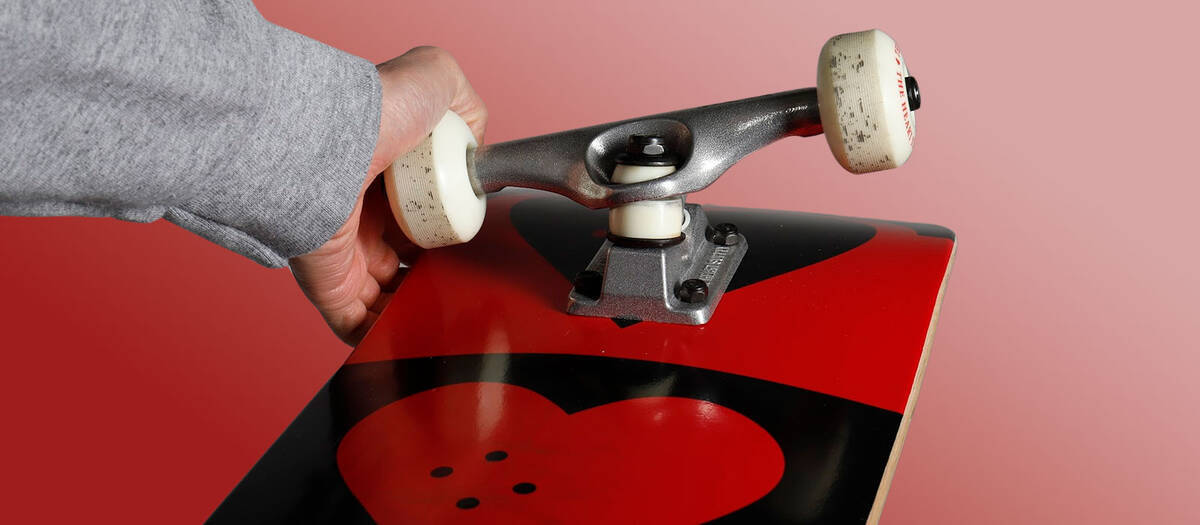Comprehensive Guide to Buying Skateboard Trucks
Selecting skateboard trucks can be daunting. However, by purchasing from a reputable skateboard truck brand and ensuring the correct size for your deck, satisfaction with your purchase is likely. When buying a complete skateboard, the trucks are pre-mounted and match the deck's width perfectly.
Overview
Understanding the Parts of a Skateboard Truck

To begin, let's cover the essentials before delving into details. What exactly constitutes skateboard trucks? In essence, trucks are the metal T-shaped components affixed to the underside of the skateboard deck. They hold the wheels and comprise two main parts that pivot against each other: the baseplate and the hanger, connected by a kingpin bolt that also secures the bushings. Here's a breakdown of the key elements of a skateboard truck:
Baseplate
The baseplate is the flat metal piece secured onto the deck with four bolts. Its primary functions are to evenly distribute the skater's weight across the entire truck, providing stability and spreading the impact of landings to the deck. Pivot cups, located in the baseplates, enable the hanger's pivoting ability, influencing turn smoothness. As the link between the deck and the hanger, the baseplate is crucial to the truck and your setup as a whole.
Hanger
The hanger is the most substantial component of a skateboard truck, featuring an oblong metal bar that tapers into a triangular form towards the pivot, fitting into the baseplate's pivot cup. The hangers grind directly on rails, copings, and ledges, playing a pivotal role in your grind tricks.
Axle
The axle, running through the hanger, is threaded on both ends where nuts are affixed to secure the wheels. Over time, the outer threads may deteriorate, particularly during numerous rail stands, but can be re-tapped with appropriate tools. Many T-tools come equipped with 5/16" axle re-threaders, perfect if you need to re-thread your trucks. Explore our selection of such tools:
Kingpin
The kingpin is a substantial bolt traversing the middle of the truck, holding all truck parts together. By adjusting the kingpin nut, you can modify your trucks' tightness. Though susceptible to breaking from stress, kingpins are replaceable.
Truck Bushings
Bushings, the rubbery supports situated between the baseplate and hanger, transfer pressure from your feet to the hangers, impacting your setup's agility. Their firmness alters your turning capability:
- Hard bushings: Firmer and more stable trucks, potentially beneficial if wobbliness is an issue. These demand extra effort to initiate turns.
- Soft bushings: Ideal for carving and cruising, and skaters preferring nimble trucks that promptly react to movements.
Discover how to install skateboard bushings, or find new bushings, washers or hardware:
With an understanding of skateboard truck components, let's move on to factors to consider when picking the right trucks for your setup.
Skateboard Truck Sizes & Measuring Guide

Skateboard truck sizes involve two dimensions: width and height. This section provides a succinct guide to help you choose the suitable size of skateboard trucks.
Truck Width of a Skateboard

It's essential to align your trucks' width with your deck's width. For optimal performance, ensure your trucks' width doesn't stray significantly from the deck's width. Narrow trucks feel unstable; wide ones can interfere with your shoes while pushing, complicating flip tricks.
Truck brands usually refer to their sizes by numbers indicative of the hanger width, excluding axle width. However, the axle width determines the overall truck width, the measurement you need to match with your deck's width.
At SkatePro, the axle width for each truck in our selection is specified, sparing you from using a skateboard truck size chart to convert the manufacturer's sizes to inches.
Height of a Skateboard Truck

Truck height is the space between the baseplate and the axles' centre. Hence, truck height (or profile) is the space between the deck and the trucks. Two primary considerations when selecting truck height are the distances from the deck to your wheels and to the ground.
Truck height is classified into high, medium, or low trucks, simplifying the choice process. Here are the features of these categories:
- Low Trucks (46-49 mm): With the deck closer to the ground, low trucks offer better control, especially for beginners, kids, and those with shorter legs, by providing more stability. Avoid exceeding 53 mm wheel diameter unless using risers to increase wheel-deck clearance!
- Mid Trucks (49.5-53.5 mm): These median trucks provide versatility, ideal for most skateboarders. At 49.5-53.5 mm, mid trucks are suitable for most skaters. Exceeding 56 mm wheel diameters requires risers.
- High Trucks (53,5-60mm): Height provides numerous benefits, such as accommodating larger wheels and creating an ideal setup for cruising and carving due to increased wheel-deck clearance. For freestyle skateboarding, high trucks offer a broader platform to balance during rail stands.
Each truck's height is specified in the descriptions within our selection.
Key Factors When Selecting Skateboard Truck Height
Truck height is largely a subjective choice influenced by your style and physical characteristics. Consider the following elements when deciding between higher or lower trucks:
- Wheel clearance: The space between wheels and deck depends on wheel diameter and truck height. Adequate clearance is crucial for carving and sharp turns. Choose accordingly if preferring loose trucks or deep turns.
- Pop angle: Increased truck height raises the pop angle. Lower trucks offer quicker response, while higher ones provide extra leverage for more substantial tricks.
- Pushing: High trucks create a larger gap between your deck foot and pushing foot, making pushing less comfortable over longer distances.
- Tricks: Different tricks vary in ease depending on truck height. High trucks give large platforms for balancing during rail or truck stands, while lower trucks' agility benefits flatland flip tricks.
- Truck weight: Larger trucks are heavier.
- Personal height: Taller individuals with longer legs might control high trucks more effectively than shorter people.
Riser Pads - Avoid Wheel Bites by Adjusting Truck Height

Riser pads provide a simple, cost-effective solution for skateboarders facing wheel bites, a frequent issue when wheels contact the deck during sharp turns. They increase the distance between the deck and wheels.
Should you wish to try larger wheels or looser trucks, riser pads may prove beneficial.
To combat wheel bites or adjust your skateboard's characteristics, consider our range of riser pads:
Ensure proper hardware when installing riser pads. For guidance on correct bolt lengths, refer to the guide below:
Skateboard Truck Weight: Should They be Heavy or Light?
Trucks contribute significantly to your complete skateboard's weight. Recent truck designs focus on trimming this weight. Hollowing kingpins and axles, and experimenting with materials, are steps taken to reduce weight.
Currently leading the market, the Tensor Mag Light Series claims to be the "lightest trucks ever". Though lighter trucks enhance trick performance, weight differences aren't necessarily as noticeable as other truck attributes.
In assessing truck weight, note the direct correlation to truck size. More massive trucks correlate with larger wheel diameters and broader deck widths.
Balancing Skateboard Trucks – Deciding Between Loose or Tight Trucks

Adjust your trucks by rotating the kingpin nut with a skate tool or spanner. A tighter nut means harder turning but increased stability, while a looser one results in more agility and responsiveness.
Reasons to tighten your trucks include:- Experiencing wheel bites during sharp turns or tricks.
- Desiring more consistent pop.
- A lack of stability at high speed.
- Allowing the front wheels to lift during turns
- Needing sharper turns
- Desiring greater lateral movement freedom
Turning and carving is influenced by bushing hardness, indicated by the durometer scale. Harder bushings (higher durometer) result in tighter trucks. Explore our range of bushings:
- Skateboard Bushings
- Guide: Adjust Your Trucks for Better Control
- Skateboard Bushings - Everything You Need to Know
Installing Your Skateboard Trucks
```Each truck is affixed using four nuts and four bolts. It is advised to tighten these bolts in a cross-diagonal manner to guarantee the baseplate is evenly secured across its entire surface.
We are here to assist you at all times:
